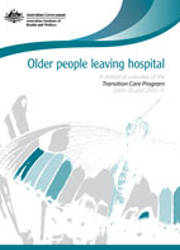Older people leaving hospital: a statistical overview of the Transition Care Program 2009-10 and 2010-11
Citation
AIHW
Australian Institute of Health and Welfare (2012) Older people leaving hospital: a statistical overview of the Transition Care Program 2009-10 and 2010-11, AIHW, Australian Government, accessed 20 April 2024.
APA
Australian Institute of Health and Welfare. (2012). Older people leaving hospital: a statistical overview of the Transition Care Program 2009-10 and 2010-11. Canberra: AIHW.
MLA
Australian Institute of Health and Welfare. Older people leaving hospital: a statistical overview of the Transition Care Program 2009-10 and 2010-11. AIHW, 2012.
Vancouver
Australian Institute of Health and Welfare. Older people leaving hospital: a statistical overview of the Transition Care Program 2009-10 and 2010-11. Canberra: AIHW; 2012.
Harvard
Australian Institute of Health and Welfare 2012, Older people leaving hospital: a statistical overview of the Transition Care Program 2009-10 and 2010-11, AIHW, Canberra.
PDF | 2.4Mb
Older people leaving hospital: a statistical overview of the transition care program 2009-10 and 2010-11 presents key statistics about transition care services provided to older people directly after discharge from hospital. The Transition Care Program aims to improve recipients' independence and functioning, and has assisted nearly 52,000 people since it started in 2005-06, including 18,000 individuals who received just under 20,300 episodes of transition care in 2010-11. The report includes for the first time an analysis of trends since the program's establishment, and an examination of the final outcomes of people receiving consecutive episodes of care.
- ISSN: 1329-5705
- ISBN: 978-1-74249-384-8
- Cat. no: AGE 71
- Pages: 72
-
TCP assisted nearly 52,000 between 2005–06 and 2010–11 through 60,500 episodes of care
-
Over the 6 years, more than 60% of people left the program with an improved level of functioning
-
In 2010–11, 3,350 places were available and the average occupancy rate was 82%
-
Some 18,000 people received care through TCP during 2010–11—and 56% of them improved in functioning



